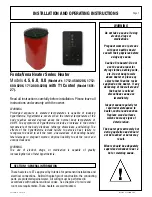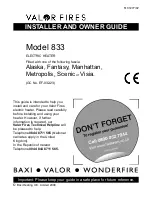
INSTALLATION AND OPERATING INSTRUCTIONS
4211-861-G 10-12-16 7013545 314 SKSM 211
B
Page 3
WARNING
SECTION 2: MOUNTING OF SAUNA HEATER
SECTION 3: PLACING OF ROCKS (SEE DIAGRAM #10)
HANGING THE HEATER Using the template provided, drill four 9/64" holes
to fasten the heater to the wall. Install two ¼" x 1 ½" hex head lag screws
(supplied with the heater) into the upper two holes. Tighten these screws
until their heads are about 1/8" from the wall surface. The screws must be
threaded through the wall into a framing member or backing board to
support the heater weight. Hang the heater on the two upper screws.
Locate the two ¼" x 1" hex head lag screws (supplied with the heater) then
install them into the two lower mounting holes. Tighten to lock the heater in
place. See Diagram 1 for the heater location details and the necessary
clearances to combustible materials.
The rocks supplied with the heater have been chosen to provide the best
heater performance. Use of any other type of rock may void the heaters
warranty. Never operate the heater without rocks in place! Rinse the rocks
with water before placing in the heater. Carefully place the rocks loosely so
that the air can circulate through the heater. Packing the rocks too tightly
may cause the heater high limit switch to trip. The rocks must fully cover
the heating elements. Attach the guard with the screws provided.
Fire sprinkler systems used
inside any sauna room should
be properly rated for sauna
room temperatures.
Do not pour chlorinated pool
or spa water on heater.
Excessive water use on heater
may cause damage and void
warranty.
Electric Shock Hazard - High
voltage exists within this
equipment. There are no user
serviceable parts in this
equipment. All installation
and service to this equipment
should be performed by
qualied licensed personnel
in accordance with local and
national codes.
Do not construct sauna room
so as to restrict air ow
through the bottom of the
heater.
Packing the rocks too tightly
may cause the heater high
limit switch to trip.
SECTION 4: ELECTRICAL HOOK-UP
SECTION 6: HEATER SCREEN (GUARD RAIL)
Electrical installation must be made by a licensed electrician in accordance
with the National Electrical Code and local regulations.
Remove the screws from the left and right sides of the electrical box.
Remove the painted trim piece from the front of the box. Route the feed
wires through the holes provided in the bottom of the heater and connect
the wires to the terminal block. To determine the correct wire size, refer to
Diagram 2. Use copper supply wire only, suitable for minimum 90 degrees
C. The heater must be grounded! See Diagram 6 for proper connections.
Install a wooden heater guard to prevent the sauna bather from accidentally
touching the sauna heater. Install the heater guard rail with the dimensions
shown in Diagram 1 & 8.
SECTION 5: TEMPERATURE SENSOR
Feed the "low voltage" sensor wire from the sensor to the T1 control
location. Sensor wire must be routed completely separate (as per low
voltage electrical wiring codes) from any wiring carrying over 50 volts. It
may be necessary to drill holes to string the wire through the studs or
ceiling joists. Route the wire to T1 controller and connect to the control
connection. Mount sensor to nished wall 2" from the ceiling directly above
the heater using two (2) screws (provided) as shown in diagrams 1, 3 & 5.





























